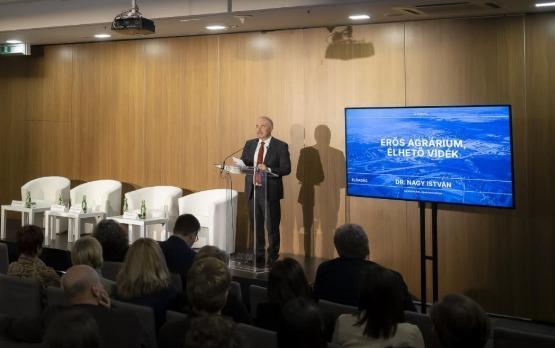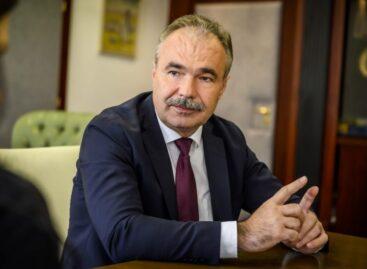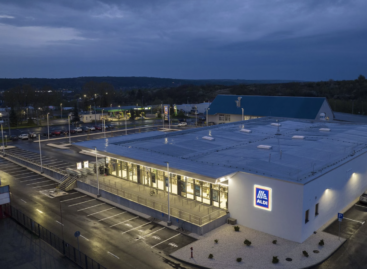The government’s policy as a whole is farmer-centric
Farmers have always been able to count on the government, the government’s policy as a whole is farmer-centric – the Minister of Agriculture stated at the Századvég Rural Conference 2025 in Budapest on Thursday.

(Photo: AM/István Fekete)
István Nagy, in his presentation entitled Strong Agriculture, Liveable Region, said that farmer-centricity is not new, and over the past decade and a half, the Hungarian countryside has been put on a growth path in alliance with farmers. Hungarian agriculture has undergone spectacular development since 2010: the machinery has been renewed, buildings, modern greenhouses, plastic houses and plantations have been created, and agrotechnology has developed – he listed. He highlighted that agricultural output has increased almost 2.5 times in 15 years at current prices, which is the largest increase in the EU. The added value of Hungarian agriculture was 1,464 billion forints in 2024, having increased by 170 percent at current prices and 46 percent at constant prices since 2010 – explained István Nagy.
The subsidies provided through the Rural Development Programme have played an outstanding role in the historical development achieved since 2010
The payment for applications has already reached 2,794 billion forints. The role of the Rural Development Programme has been taken over by the CAP Strategic Plan from 2024, the resources of which will exceed 5,650 billion forints by 2027, 55 percent of the budget can be used for agricultural and rural development purposes – he explained. He called the use of development resources important, because all actors in the sector must adapt to maintain and strengthen competitiveness. He emphasized that the government’s policy is based on strengthening the countryside. “With hard work, continuous construction, and programs and support that build on each other, we have achieved that Hungary and the Hungarian countryside have a future again,” he said, highlighting the Hungarian Village Program, which aims to strengthen and develop small settlements and improve the local quality of life. Since 2019, nearly 1,300 billion forints have been spent on the development of villages in the program.
He called it an important development for 2025 that the Hungarian Village Program was transferred to the Ministry of Agriculture, along with the other rural development programs
Its resources are included in the central budget of Hungary every year. He added that in addition to the well-known forms of support, the program was expanded this year with several new elements specifically requested by the villages. He pointed out that the Hungarian Village Program set itself the goal of ensuring that the quality of life – at the level of basic services – in all small settlements in Hungary should be at least the same as in cities. It can now be observed that small settlements are the only settlement category where the number and proportion of young children is increasing. Today, a higher proportion of families with young children choose small settlements as their home than large cities. According to him, this indicates that living in the countryside is good: Hungarian villages and small towns are safe, the air is good. Each of the beneficiary small settlements was able to move forward thanks to the program, this is due to hundreds of personal consultations and continuous dialogue, so the program responds dynamically to the needs raised – he said. In his summary, the Hungarian countryside is able to renew itself, it is able to preserve its traditions and adapt to the challenges of the future. The national government’s policy is based on strengthening the countryside – he said, adding: their goal is for the countryside to provide opportunities for prosperity, for a good life outside the big cities. The government pays special attention to rural development, whether it is agriculture, the food industry or even tourism. “We have made radical changes in the fields of agriculture and rural development. (..) Hungarian agriculture and the food industry based on agriculture have become a driving force and a national strategic sector. We can all be proud that with hard work, continuous construction, and programs and supports that build on each other, we have achieved that Hungary and the Hungarian countryside have a future” – István Nagy concluded his presentation.
AM/MTI
Related news
AM: Government helps farmers with a loan moratorium
🎧 Hallgasd a cikket: Lejátszás Szünet Folytatás Leállítás Nyelv: Auto…
Read more >More than 100 Hungarian farmers also demonstrated in Brussels
🎧 Hallgasd a cikket: Lejátszás Szünet Folytatás Leállítás Nyelv: Auto…
Read more >NAK: Domestic producers await customers with an ample supply of all pine species
🎧 Hallgasd a cikket: Lejátszás Szünet Folytatás Leállítás Nyelv: Auto…
Read more >Related news
How do young adults celebrate?
🎧 Hallgasd a cikket: Lejátszás Szünet Folytatás Leállítás Nyelv: Auto…
Read more >Vajda-Papír celebrates Ooops!’s 15th anniversary with a hybrid AI campaign
🎧 Hallgasd a cikket: Lejátszás Szünet Folytatás Leállítás Nyelv: Auto…
Read more >Pre-holiday shopping at up to half price
🎧 Hallgasd a cikket: Lejátszás Szünet Folytatás Leállítás Nyelv: Auto…
Read more >






